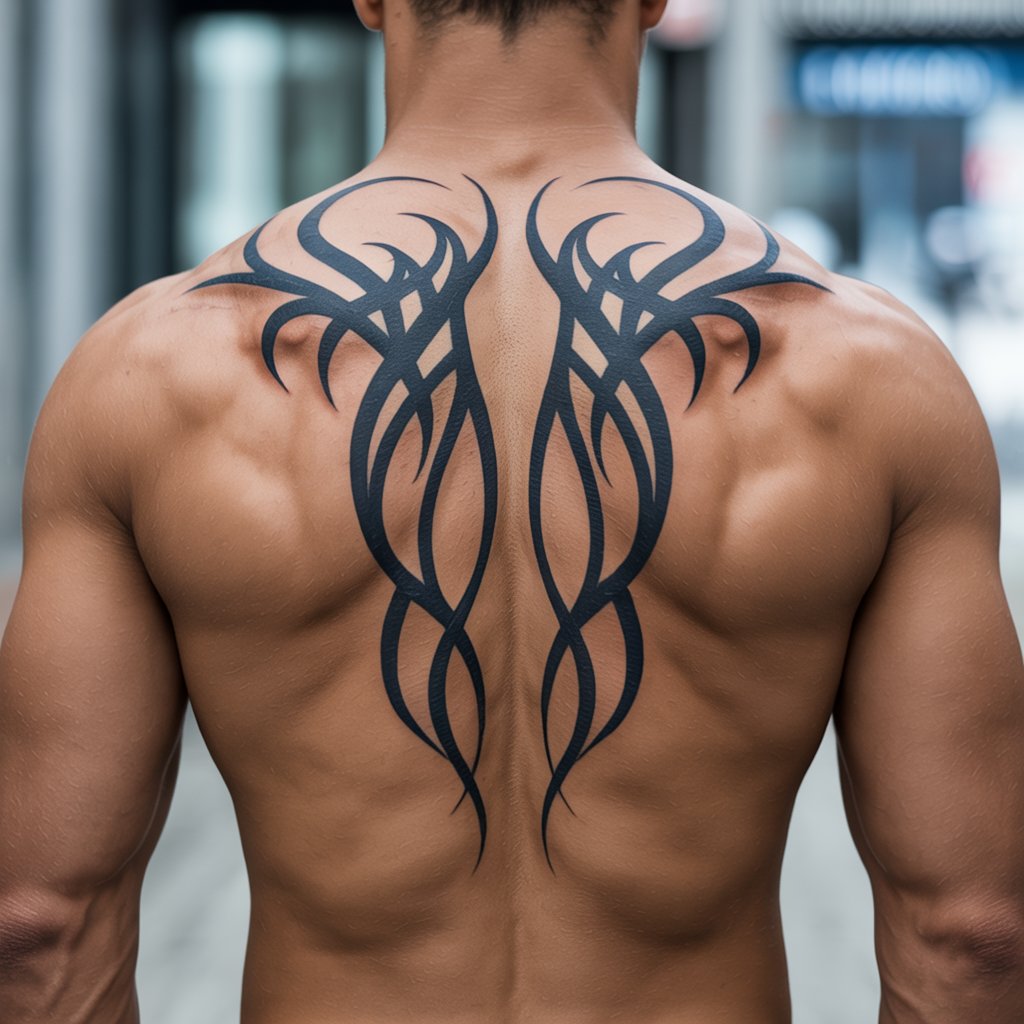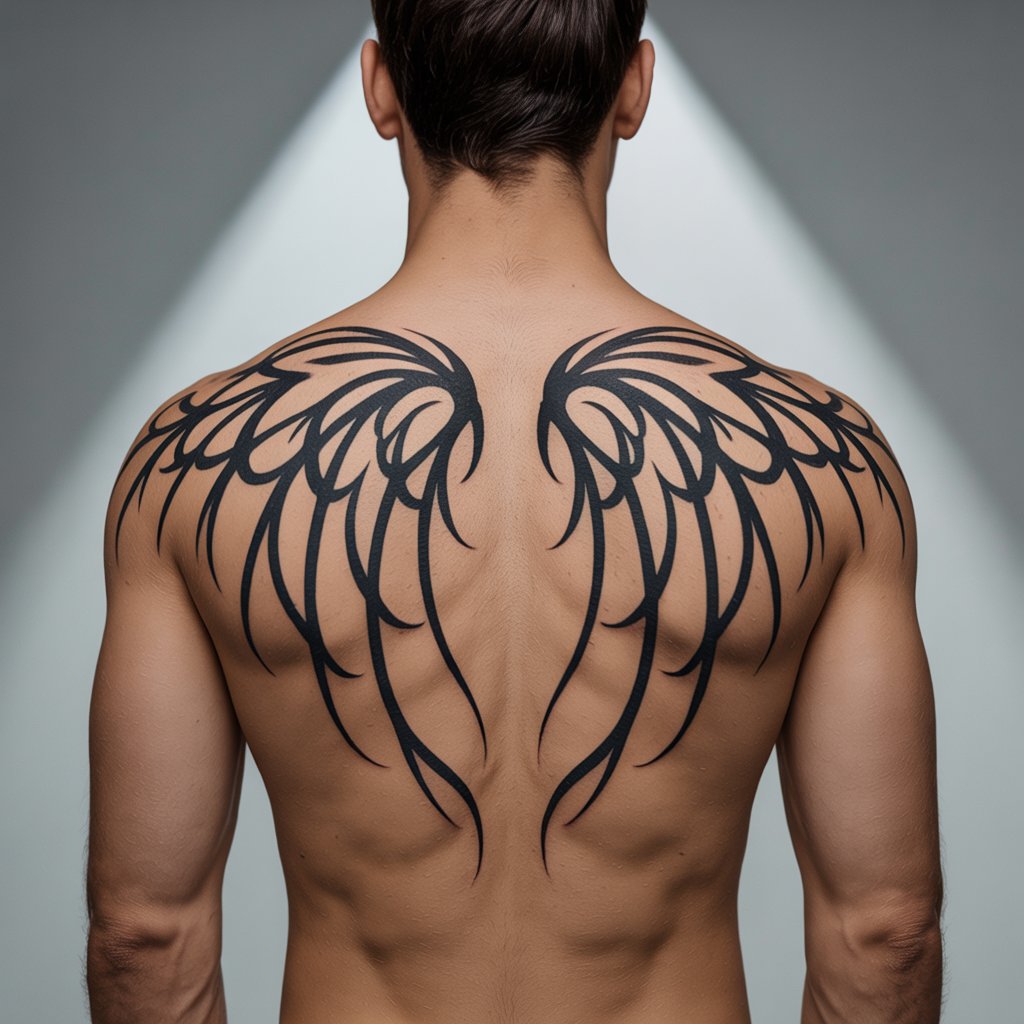In the realm of transformative body art, few designs carry the visual impact and symbolic weight of wing tattoos spanning across the back. The striking example featured here showcases the powerful aesthetic and meaningful symbolism that have made this design choice enduringly popular among tattoo enthusiasts worldwide.
Anatomical Harmony: Design and Placement
What immediately captivates the viewer about this particular wing tattoo is how perfectly it complements the human form. Several key design elements contribute to this harmonious relationship:
Anatomical Integration
Notice how the tattoo’s placement follows the natural contours of the back—the wings spread outward from the spine, extending across the shoulder blades in a way that mirrors how actual wings would emerge from a body. This placement isn’t merely decorative; it creates an illusion that the wings are an organic extension of the wearer’s physique.
Minimalist Elegance
Unlike more elaborate or colorful wing interpretations, this design embraces bold simplicity. The solid black linework creates a stark contrast against the skin, allowing the flowing curves and sharp points to make a dramatic statement without additional embellishment. This approach demonstrates how sometimes less truly is more in tattoo artistry.
Dynamic Movement
Though static on the skin, these wings convey a sense of motion and energy. The curved lines suggest wind resistance and flight, creating a visual narrative of movement that animates the entire back. This dynamic quality breathes life into the design, making it appear almost ready to take flight.
Symbolic Dimensions
Wing tattoos carry rich layers of meaning that often motivate their selection:
Liberation and Transformation
Perhaps the most universal symbolism associated with wings is freedom—the ability to rise above limitations, both literal and metaphorical. For many wearers, back wings represent personal liberation from constraints, whether emotional, psychological, or situational.
Spiritual Protection
In numerous cultural and religious traditions, wings are associated with guardian angels or protective spirits. Placed across the back—a vulnerable area we cannot see ourselves—wings can symbolize a protective force watching over aspects of our lives beyond our direct control.
Aspiration and Achievement
Wings have long represented human ambition and the desire to transcend ordinary limitations. A back wing tattoo can serve as a permanent reminder of goals achieved or still pursued—a visual declaration of refusing to be bound by earthly constraints.
Artistic Considerations
Creating effective wing tattoos requires specific artistic skills and considerations:
Symmetry and Balance
The human eye is highly sensitive to asymmetry, particularly in designs that mirror the body’s natural bilateral symmetry. This example showcases excellent balance between the left and right wings, creating a cohesive whole while allowing subtle variations that enhance the organic feeling of the design.
Scale and Proportion
The impact of back wings comes largely from their bold scale. This design demonstrates perfect proportional balance—large enough to make a dramatic statement while respecting the boundaries of the canvas. The wings extend to the shoulders but don’t overreach, maintaining visual harmony with the wearer’s frame.
Line Quality and Flow
The strength of this minimalist design rests heavily on the quality of its linework. Note how the lines vary in thickness and curve with precision, creating depth and dimension without shading. This technical mastery allows the simple design to convey considerable visual complexity.

Contemporary Interpretations
While wing tattoos have ancient roots in various cultures, modern designs reflect contemporary aesthetics:
Tribal Influence
This particular design draws inspiration from tribal tattooing traditions while incorporating a more graphic, contemporary edge. The result honors historical practices while creating something distinctly modern.
Masculine Minimalism
The clean, bold lines and absence of decorative elements create a design that reads as masculine without resorting to clichés. This approach to masculine aesthetics focuses on strength through simplicity rather than aggression or excessive ornamentation.
Artistic Restraint
In an era where complex, highly detailed tattoos have become common, this design demonstrates the powerful impact of artistic restraint. By focusing on essential forms and perfect placement, it achieves maximum visual impact with minimal elements.
Practical Considerations
For those inspired by this tattoo, several practical factors merit consideration:
Pain and Endurance
Back tattoos, particularly those covering substantial area, involve significant physical discomfort during the tattooing process. The spine, shoulder blades, and areas close to bone typically present the greatest challenge, making this a commitment that requires both physical and mental preparation.
Session Planning
Large-scale back pieces like this typically require multiple sessions to complete. Working with an artist to develop a realistic timeline helps manage expectations and ensures proper healing between sessions.
Long-term Evolution
Black linework tattoos generally age well compared to more detailed or colorful designs. However, understanding how the tattoo will evolve with time and body changes helps in making informed design choices. Solid, bold lines like those shown here tend to maintain their integrity over decades.
Finding the Right Artist
A tattoo of this significance demands careful artist selection:
Portfolio Assessment
Look specifically for artists who demonstrate excellence in large-scale geometric or tribal work. Pay particular attention to line quality and symmetry in their previous pieces.
Design Collaboration
The most successful back wings result from true collaboration between artist and client. Finding an artist who listens to your symbolic intentions while offering expert guidance on execution ensures a result that satisfies both aesthetically and personally.
Personalization Possibilities
While this example showcases a compelling minimalist approach, wing designs offer extensive customization possibilities. From incorporating personal symbols to varying the style from tribal to realistic, wings provide a versatile framework for personal expression.
The Enduring Appeal
What explains the continued popularity of wing tattoos across decades? Perhaps it’s because they speak to something fundamentally human—our eternal desire to transcend limitations and transform ourselves. Back wings create a powerful visual metaphor for this aspiration, turning the wearer’s body into a canvas for expressing the perennial human dream of flight.
When executed with artistic precision and placed with anatomical understanding, back wings represent one of tattooing’s most powerful statements—a perfect union of symbolic meaning and visual impact that continues to inspire both tattoo artists and collectors alike.
This article explores the artistic elements and symbolism of back wing tattoos. For those considering similar body art, consulting with a tattoo artist who specializes in large-scale work is essential to achieve the striking impact showcased in this example.


